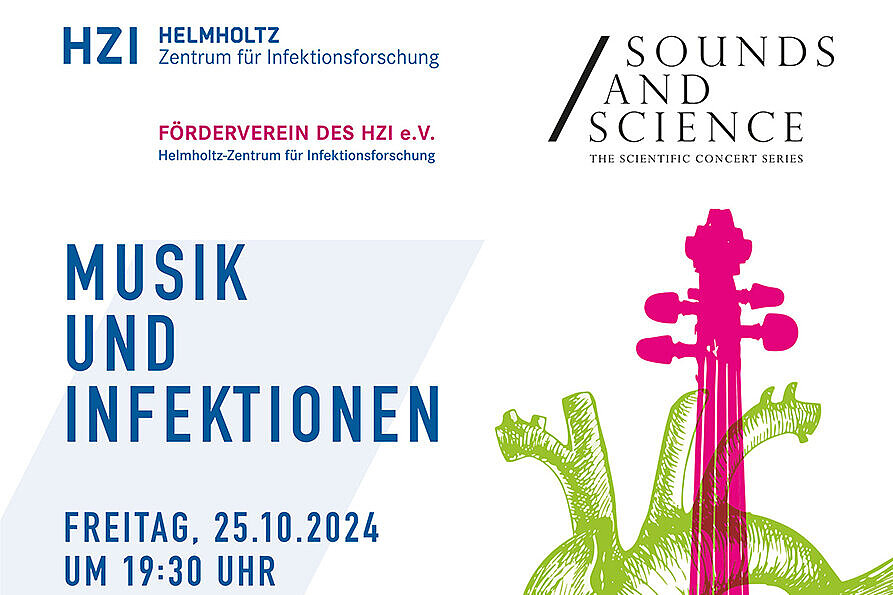![[Translate to English:] Mikroskopische Aufnahme](/fileadmin/_processed_/4/6/csm_2024-09-16_htert_UL82_plusISD_t-IRF3_SD60x_-MaxIP_v2_49e1466326.png)
Virology and Innate Immunity

Our Research
Herpesviruses are extremely complex viruses. We are just beginning to understand exactly how these pathogens manipulate our immune system to establish lifelong infections. In order to develop new therapies and vaccines, it is first necessary to understand the intimate interplay between herpesviruses and their hosts.
Research in the “Virology and Innate Immunity” group focuses on how herpesviruses are recognized by the innate immune system. In addition, our research analyzes how these viruses so successfully establish lifelong, chronic infections. The question of how herpesviruses circumvent or weaken the defensive line of our innate immune system plays a central role, as this is a requirement for the viruses to successfully establish lifelong infection.
Fundamental research for development of novel therapies
Via millions of years of coevolution, herpesviruses have adapted themselves perfectly to their hosts. They know exactly which switches to pull to weaken certain aspects of the immune response as well as to enhance responses that benefit them. The mechanisms used by herpesviruses to manipulate our immune system are explored in research projects in the “Virology and Innate Immunity” group. One goal of the research group is to identify novel viral proteins that are directly involved in manipulation of immune defenses. These proteins are potential targets for the development of new antiviral therapies. Another focus of our research is the characterisation of the pro- or antiviral role of interferon-stimulated gene products during herpesviral infections and their mechanism of action.
Spotlight: the herpesviruses CMV and KSHV
Research in the “Virology and Innate Immunity” group focuses on two members of the herpesvirus family: human herpesvirus 5, also known as cytomegalovirus (CMV), and human herpesvirus 8, or Kaposi’s sarcoma-associated herpesvirus (KSHV).
CMV is a common pathogen, thought to infect half of the European population. In many healthy individuals, CMV infection is unrecognized - it may cause mild illness or even be completely asymptomatic. However, in patients with weakened immune systems, for example in HIV/AIDS patients and transplant recipients, CMV infection can cause severe complications.
In addition, CMV infection of the mother during pregnancy can lead to infection of the fetus, which can result in permanent damage observed at birth or later in childhood. CMV-induced birth defects include mental handicap, deafness, microcephaly, and/or visual impairment. In fact, CMV infection during pregnancy is the most common cause of non-genetic deafness in children.
To date, there is no vaccine against CMV and there is only a limited selection of antiviral drugs available, which are unfortunately accompanied by serious side effects.
KSHV was first discovered in 1994. Since then, it has been identified as the causative agent of at least three types of cancer:
- a cancer of blood vessels, known as Kaposi’s sarcoma,
- a type of lymphoma, or cancer of white blood cells, known as primary effusion lymphoma,
- a form of lymph node enlargement, known as multicentric Castleman’s disease.
The goal of our research activities is to gain novel insights into the interplay between the herpesviruses CMV and KSHV and their hosts, and thus better understand how these viruses cause illness. These insights are the foundation required to develop innovative, specific therapies against herpesviruses.
Our Research
Herpesviruses are extremely complex viruses. We are just beginning to understand exactly how these pathogens manipulate our immune system to establish lifelong infections. In order to develop new therapies and vaccines, it is first necessary to understand the intimate interplay between herpesviruses and their hosts.
Research in the “Virology and Innate Immunity” group focuses on how herpesviruses are recognized by the innate immune system. In addition, our research analyzes how these viruses so successfully establish lifelong, chronic infections. The question of how herpesviruses circumvent or weaken the defensive line of our innate immune system plays a central role, as this is a requirement for the viruses to successfully establish lifelong infection.
Fundamental research for development of novel therapies
Via millions of years of coevolution, herpesviruses have adapted themselves perfectly to their hosts. They know exactly which switches to pull to weaken certain aspects of the immune response as well as to enhance responses that benefit them. The mechanisms used by herpesviruses to manipulate our immune system are explored in research projects in the “Virology and Innate Immunity” group. One goal of the research group is to identify novel viral proteins that are directly involved in manipulation of immune defenses. These proteins are potential targets for the development of new antiviral therapies. Another focus of our research is the characterisation of the pro- or antiviral role of interferon-stimulated gene products during herpesviral infections and their mechanism of action.
Spotlight: the herpesviruses CMV and KSHV
Research in the “Virology and Innate Immunity” group focuses on two members of the herpesvirus family: human herpesvirus 5, also known as cytomegalovirus (CMV), and human herpesvirus 8, or Kaposi’s sarcoma-associated herpesvirus (KSHV).
CMV is a common pathogen, thought to infect half of the European population. In many healthy individuals, CMV infection is unrecognized - it may cause mild illness or even be completely asymptomatic. However, in patients with weakened immune systems, for example in HIV/AIDS patients and transplant recipients, CMV infection can cause severe complications.
In addition, CMV infection of the mother during pregnancy can lead to infection of the fetus, which can result in permanent damage observed at birth or later in childhood. CMV-induced birth defects include mental handicap, deafness, microcephaly, and/or visual impairment. In fact, CMV infection during pregnancy is the most common cause of non-genetic deafness in children.
To date, there is no vaccine against CMV and there is only a limited selection of antiviral drugs available, which are unfortunately accompanied by serious side effects.
KSHV was first discovered in 1994. Since then, it has been identified as the causative agent of at least three types of cancer:
- a cancer of blood vessels, known as Kaposi’s sarcoma,
- a type of lymphoma, or cancer of white blood cells, known as primary effusion lymphoma,
- a form of lymph node enlargement, known as multicentric Castleman’s disease.
The goal of our research activities is to gain novel insights into the interplay between the herpesviruses CMV and KSHV and their hosts, and thus better understand how these viruses cause illness. These insights are the foundation required to develop innovative, specific therapies against herpesviruses.
Prof Dr Melanie Brinkmann
Over a million years herpesviruses have adapted perfectly to the immune system and efficiently outwit the body's defence. We want to decipher the mechanisms herpesviruses apply to escape their elimination.

Melanie Brinkmann studied biology at the Georg-August University of Göttingen, the Humboldt University of Berlin and the Imperial College in London. During her PhD at the Institute of Virology, Hannover Medical School, Germany, she studied how the tumorvirus Kaposi sarcoma-associated herpesvirus (KSHV) manipulates its host. For her postdoctoral time she joined Hidde Ploeghs laboratory at the Whitehead Institute for Biomedical Research, which is associated with the Massachusettes Institute of Technology in Cambridge, USA. During these four years she worked on highly specialized sentinels of the innate immune system, so called pattern recognition receptors. These cellular receptors play an essential role for the detection of viral infections.
Since July 2010 Melanie Brinkmann is head of the research group “Virology and Innate Immunity” at the HZI.
She received the PhD Award of the Hannover Medical School (2004), for her postdoctoral work she received the Robert-Koch-Postdoc Award (2007), and in 2016 she was awarded with the Science Award of the Signal Transduction Society. In 2022, the Conference of Biology Departments (KBF) awarded Melanie Brinkmann the ScienceHero Prize. With this award, the KBF recognizes people and organizations that stand for good teaching and creative research. In particular, the ScienceHero Award honored her role in science communication and knowledge transfer during the coronavirus pandemic.
From 2012 to 2018, Melanie Brinkmann was assistant professor at the Institute of Virology at the Hannover Medical School. Since July 2018 she is professor at the Institute of Genetics at the Technische Universität Braunschweig.
Melanie Brinkmann is elected advisory board member of the German Society of Virology (GfV) since 2020, elected member of the DFG Review Board 2.21 ‘Microbiology, Virology and Immunology’ since 2024, and served as Co-chair of the SARS-CoV-2-Pandemic Expert Advisory Group of the German Federal Government from 12/2021 to 04/2023. She is founding member of the BMBF-funded network of female scientists in the area of infection research (Infect-Net).
Team












Selected Publications
Stempel M, Maier O, Mhlekude B, Drakesmith H, Brinkmann MM.
Novel role of bone morphogenetic protein 9 in innate host responses to HCMV infection.
EMBO reports vol. 25,3 (2024): 1106-1129. (DOI: 10.1038/s44319-024-00072-2)
Schwanke H, Gonçalves Magalhães V, Schmelz S, et al.
The Cytomegalovirus M35 Protein Directly Binds to the Interferon-β Enhancer and Modulates Transcription of Ifnb1 and Other IRF3-Driven Genes.
J Virol. 2023;97(6):e0040023. (DOI: 10.1128/jvi.00400-23)
Gonzalez-Perez AC, Stempel M,Wyler E, Urban C, Piras A, Hennig T,Ganskih S, Wei Y, Heim A, Landthaler M,Pichlmair A, Dölken L,Munschauer M, Erhard F, Brinkmann MM, 2021.
The Zinc Finger Antiviral Protein ZAP Restricts Human Cytomegalovirus and Selectively Binds and Destabilizes Viral UL4/UL5 Transcripts.
mBio 12:10.1128/mbio.02683-20. (DOI: 10.1128/mBio.02683-20.)
Günther T, Czech‐Sioli M, Indenbirken D, Robitaille A, Tenhaken P, Exner M, Ottinger M, Fischer N, Grundhoff A, Brinkmann MM.
SARS‐CoV‐2 outbreak investigation in a German meat processing plant
EMBO Mol Med. 2020. e13296 (DOI: 10.15252/emmm.202013296)
Stempel M, Chan B, Juranić Lisnić V, Krmpotić A, Hartung J, Paludan SR, Füllbrunn N, Lemmermann NA, Brinkmann MM.
The herpesviral antagonist m152 reveals differential activation of STING-dependent IRF and NF-κB signaling and STING's dual role during MCMV infection.
EMBO J. 2019 Jan 29. pii: e100983. [Epub ahead of print] (DOI: 10.15252/embj.2018100983)
A complete list of publications can be found here.
DEEP-DV consortium (FOR5200) DEEP-DV
Further information on the DEEP-DV consortium can be found here.
InfectNET
Further information about the Network of German Female Infectional Researchers you can find here.





